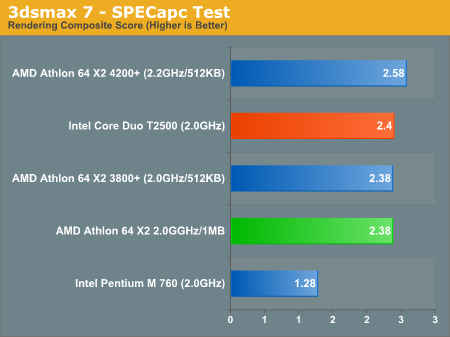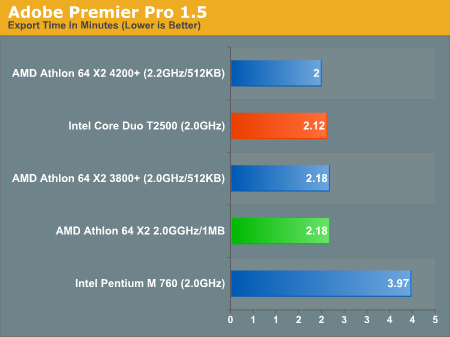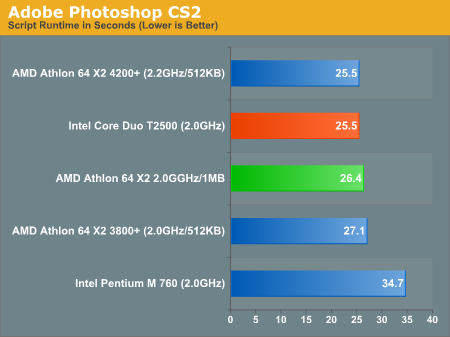Intel Core Duo (Yonah) Performance Preview - Part II
by Anand Lal Shimpi on December 19, 2005 12:55 PM EST- Posted in
- CPUs
Professional Application Performance with 3dsmax, Adobe Premier and Photoshop
We start off our page on professional application performance with an updated version of the SPECapc 3dsmax test, updated for version 7 of the application. The scenes being rendered haven't actually changed, but the reference numbers used to compute the composite scores have, so these scores aren't directly comparable to results from earlier SPECapc tests.
Compared to the Athlon 64 X2, the Core Duo comes out on top, but by a very small margin - once again we're faced with a virtual tie.
The breakdown of the rendering composite score can be found below; the scores in the table are render time in seconds, lower numbers are better:
Moving onto Adobe Premier Pro 1.5, this test is actually one that is used by Intel to showcase the performance of the Pentium 4 processor. With the Pentium 4 absent from this comparison, we were curious as to how it compared to the Core Duo and the Pentium M.
As with virtually any media encoding performance, dual-core processors do extremely well, and this case is no different with the Core Duo T2500 seriously outpacing the Pentium M 760.
The Core Duo T2500 is also able to complete the export process in about 97% of the time of the Athlon 64 X2, which once again ends up being borderline negligible for this test, but it is important to note that this advantage comes without the aid of an on-die memory controller.
Our final test is the only other Intel-supplied test in the suite. This one used to showcase the Pentium 4's performance under Adobe Photoshop CS2 by measuring the time that it takes to run a few filters and resize/export images. The script itself is fairly realistic; however, with Photoshop filters, it is easy to favor one architecture over another, so by no means are these numbers intended to be conclusive of Photoshop CS2 performance.
We start off our page on professional application performance with an updated version of the SPECapc 3dsmax test, updated for version 7 of the application. The scenes being rendered haven't actually changed, but the reference numbers used to compute the composite scores have, so these scores aren't directly comparable to results from earlier SPECapc tests.

Compared to the Athlon 64 X2, the Core Duo comes out on top, but by a very small margin - once again we're faced with a virtual tie.
The breakdown of the rendering composite score can be found below; the scores in the table are render time in seconds, lower numbers are better:
| SPECapc 3dsmax 7 Breakdown | AMD Athlon 64 X2 4200+ | AMD Athlon 64 X2 3800+ | AMD Athlon 64 X2 2.0GHz/1MB | Intel Core Duo T2500 | Intel Pentium M 760 |
| 3dsmax 5 rays | 15.406 | 15.829 | 16.109 | 14.297 | 25.246 |
| CBALLS2 | 20.125 | 22.281 | 22.094 | 21.187 | 42.201 |
| SinglePipe2 | 92.844 | 101.906 | 101.922 | 107.359 | 203.492 |
| UnderWater | 142.938 | 157.219 | 156.203 | 169.188 | 316.055 |
Moving onto Adobe Premier Pro 1.5, this test is actually one that is used by Intel to showcase the performance of the Pentium 4 processor. With the Pentium 4 absent from this comparison, we were curious as to how it compared to the Core Duo and the Pentium M.

As with virtually any media encoding performance, dual-core processors do extremely well, and this case is no different with the Core Duo T2500 seriously outpacing the Pentium M 760.
The Core Duo T2500 is also able to complete the export process in about 97% of the time of the Athlon 64 X2, which once again ends up being borderline negligible for this test, but it is important to note that this advantage comes without the aid of an on-die memory controller.
Our final test is the only other Intel-supplied test in the suite. This one used to showcase the Pentium 4's performance under Adobe Photoshop CS2 by measuring the time that it takes to run a few filters and resize/export images. The script itself is fairly realistic; however, with Photoshop filters, it is easy to favor one architecture over another, so by no means are these numbers intended to be conclusive of Photoshop CS2 performance.

Overall System Performance using WorldBench 5
Media Encoding Performance with DVD Shrink, WME, Quicktime and iTunes










103 Comments
View All Comments
Furen - Monday, December 19, 2005 - link
The P6 has two FP units: An FADD unit and an FMUL unit. One of the big weaknesses of the P6 is the fact that the FMUL unit is not fully-pipelined but instead uses part of the FADD unit for FMUL operations. The K7, on the other hand, has three fully-pipelined units, an FADD, an FMUL and an FSTORE.tayhimself - Monday, December 19, 2005 - link
No he's not. AT's hardware reviewers are nublets. One thing to note though, Dothan FPU is better than the P4's hence its gaming performance advantage over the P4 in the old tests that everyone saw. It's likely that Yonah FPU is still the same as Dothan (similar to P3) and inferior to AMD's.saratoga - Monday, December 19, 2005 - link
Actually the FPU on the P4 was tremendously more powerful then Dothan or Yonah. While games do use the FPU, they're not that bottlenecked by it on modern systems. The reason Dothan did so well was because of its large, very low latency L2 cache. This is roughly equivilent to the primary advantage of the K8, a very low latency memory controller.tayhimself - Monday, December 19, 2005 - link
Youre right about the low latency L1/L2 caches on the Dothan, but the P4 (Williamette/Northwood) has those as well. But the P4 FPU is only powerful in SSE2 mode where it can load store larger chunks of data. Not all games use that unfortunately.saratoga - Monday, December 19, 2005 - link
You're wrong on several points.First:
Dothan L2 latency (clks): 10 clks
Northwood L2 latency (clks): 18 clks (approximately)
So Dothan's L2 cache is roughly 2x as fast and 4x as large. If you compare prescott with its amazingly slow L2, the situation is even more biased towards Dothan. Clearly, in terms of cache performance Dothan has a massive advantage, at least once you're out of the L1.
Second, you're confusing SSE2 and vector processing. While SSE2 can perform vector ops, it also handles plan scaler as well. In x86-64 SSE actually replaces the traditional x87 unit. The relative performance of the two is irrelevent however, the P4 was faster in both.
coldpower27 - Monday, December 19, 2005 - link
Dothan I agree with as having 10 Cycle Cache.
Northwood has 16 Cycle Cache.
Well you also got to keep in mind northwoods clock frequency plays a role in speeding up the cache, accces latencies for Dothan @ 2.0GHZ vs Northwood @ 3.2GHZ are basically equivalent. Though the 2.26GHZ Dothan has the fastest cache of all.
AlexWade - Monday, December 19, 2005 - link
Although, "Core Duo" is a stupid name. Why does Intel have to be so different? "Core Duo" is a little confusing. Is Duo a code name? What?However, despite the stupid name, we've really turned a corner in performance. Intel can make a good CPU when they realized speed isn't the future. Looks like I should start considering replacing my old Pentium-M IBM T40p with the awesome battery life.
AMD needs to respond in kind with a great new CPU. The future looks bright. Competition is once again is good for everyone.
LuxFestinus - Tuesday, December 20, 2005 - link
The ambiguously gay duo, with Ace and Gary.:) An old SNL skit.ksherman - Monday, December 19, 2005 - link
Personally, i dont like that AMD is just sitting back, seemingly waiting for Intel to catch up... They need to kick Intel while their down. these new Processors from intel look really nice and i am likely to buy one, but in a mactel laptop. I am happy for INtel that they are catching up, but AMD really NEEDS to step up and do soemthing new.Calin - Tuesday, December 20, 2005 - link
AMD's income is lower than Intel uses for R&D. You really can't expect from AMD to develop something faster than Intel can.For AMD, to have an processor they could improve a step at a time since the introduction of the Athlon64/Opteron was a need - Intel is able to mantain several teams for microprocessor development, but AMD only has money for one. And AMD will milk the market for as much as possible, selling processors that are easy to make for prices that market will accept. If AMD will start selling a higher processor grade, they would need to reduce the price for lower speed processors. This is why the 2800+ and 3000+ are discontinued - they would have to sell them too cheap.